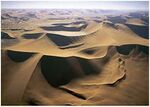Sand volcano
The sand volcano is a geological phenomenon which erupts mass quantities of sand instead of lava, although this is mainly due to geographical location. 94% of the world's active sand volcanoes are found in desert areas, with the Atacama Desert of South America being the most common locality on the planet. They are also one of the Earth's deadliest natural disasters, with the former residents of Pompeii in Japan once having their faces eroded off from ultra-fast travelling aeolian sand during the infamous Vesuvius eruption.
Geological Processes[edit]
As sand accumulates within desert regions (commonly blown here from distant sand volcano eruptions), the weight of newer sand above compacts the lower sand and pushes this deep into the earth where it mixes with large bodies of groundwater that accumulate below the MOHO. Here the sand is heated by large molten bodies where the sand will either stay here and form marble, or be erupted back to the surface along mantle plumes or subterranean cave systems (hence why caves are comonly filled with sediment).
On meeting the surface, the sand is projected up to several hundred metres into the atmosphere due to the large pressure changes involved on meeting the surface. 99% of the water from the mixture is lost by this point due to perspiration which results in a thick sandy cloud which rises above and can be seen from several miles away. The San Pedro-Pellado volcanic eruption in Chile however produced a sand cloud which was seen as far away as Georgia (not the American one, but the real one in Europe) which shows just how violent such eruptions can be.
Deposits[edit]
Vast quantities of sand ejection commonly cover large areas of the planets surfaces, creating what is widely known as a desert. The sandy tephra fall is commonly sorted through the air, forming well-sorted sands which can be over a kilometre thick and extend over hundreds of miles. The largest sand volcano tephra deposit is the Sahara Desert which was slowly produced from eruptions of the Jebel Marra volcano of Sudan and the Waw an Namus mosquito hell-hole volcano of Libya. This previously caused geologists and sedimentologists great confusion as to how sedimentary environments could suddenly change from shallow marine storm dominated sequences to aeolian deserts over a day of geological time until they realised they were suddenly buried under masses of sand.
However, large volumes of sand are often held in the atmosphere after large eruptions, commonly causing sandstorms within the stratosphere which can become troublesome for airline pilots. On reaching the Mesosphere however, temperatures can drop to -100 degrees celcius which causes small droplets of water held upon the surface the individual grains of sand to freeze. This forms large ice encrusted grains which then fall to the earth's surface as hail stones.
Sand Storms[edit]
Sandstorms are also commonly produced by sand volano eruptions and often resemble pyroclastic flows produced from conventinal lava volcanoes. If it's a windy day, these might become faster and faster until small buildings, mud-huts and tents are obliterated from the sheer mass of sand being transported. Such 'storms' are lethal combinations of erosive sand particles and hot glowing sand inside. Scientists are unsure of the composition as nobody has ever been inside of one and survived.


